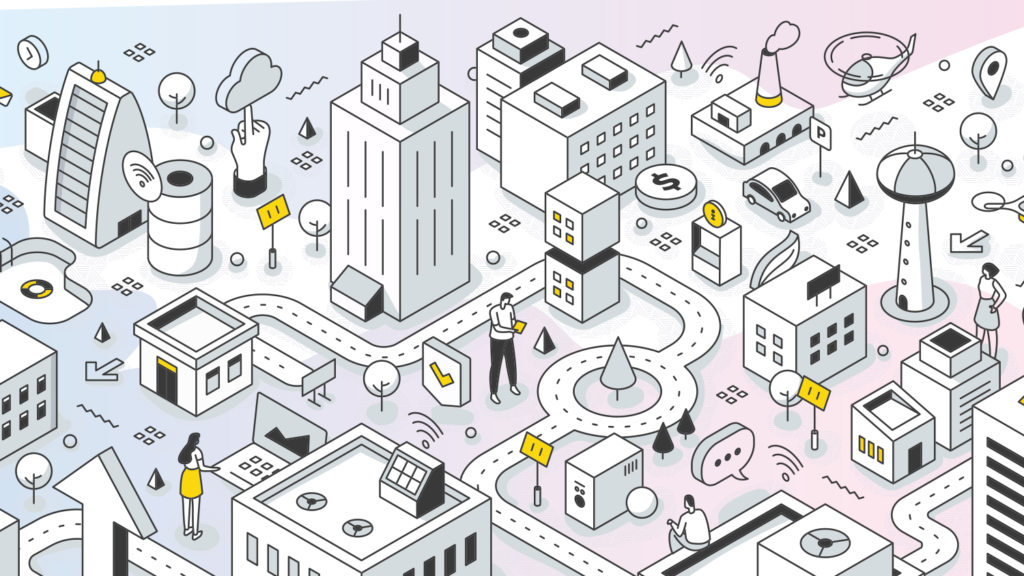
For the post-pandemic city
COVID-19 brought the benefits of digitalisation into sharp relief, which in turn accelerated the digitisation process in many areas of business and society. For companies, the most obvious advantage of ‘going digital’ was the ability to keep operating from their employees’ homes. Such decentralisation by individual enterprises also helped bring outbreaks under control and kept employees safe. Likewise, civil engineers learned that decentralisation can help municipal authorities respond quicker to pandemics, natural disasters and other crises. As explained by Arup in this article, diseases shape cities. But what if we were able to instead shape our cities to better fight diseases?
Recent months have seen life disrupted in every city in the world. The variety and imagination of responses to this crisis has given urban planners a huge source for insight. As with any experiment, the findings may take time to review and adopt. But already they point to practical ways in which we can and should be improving the planning and design of our cities. Here are three challenges reshaping urban planning:
- How can access to the real-time information that helps cities survive crises be improved?
- What can urban planners do to reduce the impact of a crisis on disadvantaged communities?
- How should public services be designed to cope with surges in demand?
We need city-wide digital transformation
Before COVID-19, digital transformation was largely a priority within individual sectors. The pandemic has proved the need for real-time, geo-located information that is publicly available to city managers across all sectors.
We should no longer consider the digitalisation of health, sanitation, transport, supply chains, or even labour practices in isolation. Digital strategies must embrace the provision of all public services in an interconnected way.
This matters because our cities will increasingly combine physical facilities with virtual environments and services. The surge in use of digital networks during lockdowns has challenged views on the speed and scale at which digitalisation can be delivered.
Already, 5G networks are starting to give us greater capacity and reliability. These networks should not only improve the accuracy and effectiveness of disaster response; they will also underpin an ability to respond better and faster to the changing social and economic needs of those who live and work in our cities.
Design should work for everyone
Every time an unforeseen event occurs, lessons are learned for the better design of urban environments and health systems. This was true of H1N1, SARS and Ebola, and will be true, now, of COVID-19. Following those earlier epidemics, unfortunately, the lessons were not always shared equally across all districts of a city. Findings were typically not implemented in city outskirts or in areas with higher proportions of poorer or more vulnerable residents.
The increasing density of our cities has allowed for greater connectivity and mobility. It has helped make our cities more sustainable. But how do we manage density when a contagious disease risks turning those advantages into threats? Effective information sharing becomes essential at these times. The communities excluded from the lessons of previous health crises typically have less access to these information-sharing networks. How can we address this in order to see all residents benefit equally from the lessons we learn from this pandemic?
In a post-lockdown world, we have the opportunity—some may say responsibility—to give marginalised groups equal consideration in our planning as we reshape our communication networks and our wider cities.
Decentralise to build immunity to crisis
Many of the public services essential to a city are managed centrally by a single organisation. The surge in demand for those services caused by the pandemic exposed how painfully vulnerable such centralised organisations are in times of crisis. During the SARS outbreak in Singapore, for instance, three key hospitals were forced to close as the city fought to contain the disease. During COVID, severe disruption to supplies of personal protective equipment put shocking numbers of staff at risk in Italy’s hospitals. Will designers of urban systems learn the lessons this time and make decentralisation an integral part of their planning?
Privatisation and decentralisation of public services, such as waste collection and healthcare, have proven effective in delivering operational efficiencies. During a crisis, decentralisation delivers another strength: resilience. It reduces the single points of failure that make centralised systems so vulnerable.
Coming out of this pandemic, urban resilience should be a top priority for policymakers. As well as decentralisation, we should be considering the risks of cross-contamination between related urban systems. For example, following the SARS epidemic, Hong Kong introduced regulation to improve the collection and management of wastewater after discovering the virus was transmitted through connected drainage systems.
Urban development has health implications
The COVID-19 pandemic has raised new questions, forcing us to reassess the way we design our cities. Without giving up on the idea of the city as a social hub, the crisis has provided an opportunity to rethink the relationship between urban design and public health. The ability to assess and mitigate the effects that development has on health should become a new field of expertise, to help prepare cities to respond more rapidly and efficiently in future.
Arup is the creative force at the heart of many of the world’s most prominent projects in the built environment and across industry. Working in more than 140 countries, the firm’s designers, engineers, architects, planners, consultants and technical specialists work with our clients on innovative projects of the highest quality and impact.
Founded in 1946 with an enduring set of values, our unique trust ownership fosters a distinctive culture and an intellectual independence that encourages collaborative working. This is reflected in everything we do, allowing us to develop meaningful ideas, help shape agendas and deliver results that frequently surpass the expectations of our clients.


Recent Comments